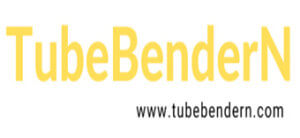All You Need to Know About Mandrel Tube Bender
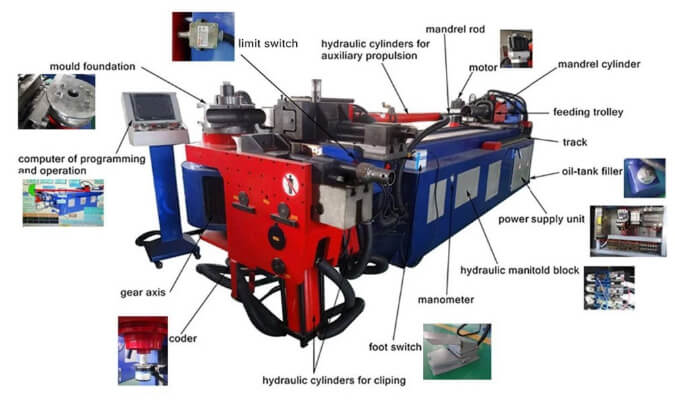
- What is A Mandrel Tube Bender?
- What is CNC Tube Bender?
- What is Fully Electric Tube Bending Machine?
- Advantages of Fully Electric Tube Bending Machine
- Disadvantages of Fully Electric Tube Bending Machine
- Application of All-Electric Tube Benders
- What is CNC Servo-Hydraulic Tube Bending Machine
- Advantages of CNC Servo-Hydraulic Tube Bending Machine
- Disadvantages of CNC Servo-Hydraulic Tube Bending Machine
- Application of CNC Servo-Hydraulic Tube Bending Machine
- What is NC Tube Bender?
- What is Semi-Automatic NC Hydraulic Tube Bending Machine
- Advantages of Semi-Automatic NC Hydraulic Tube Bending Machine
- Disadvantages of Semi-Automatic NC Hydraulic Tube Bending Machine
- Application of Semi-Automatic NC Hydraulic Tube Bending Machine
- What is Twin Head Tube Bender?
- Advantages of Twin Head Tube Bender
- Disadvantages of Twin Head Tube Bender
- Application of Twin Head Tube Bender
- What Materials Can Be Bent on Mandrel Tube Bender?
- Drive System of Mandrel Pipe Bending Machine
- Control System of Mandrel Tube Bender
- Types of Pipe Bending Tools
- Material of Pipe Bending Tools
- When Do I Need A Mandrel To Bend A Pipe?
- How Do I Know Which Mandrel Fit for My Request?
- What is Pipe Bending Radius?
- Customization Options for the Mandrel Tube Bender
- How Much Does A Mandrel Tube Bender Cost?
- FAQs about Mandrel Tube Bender
Mandrel tube bender is a tube bending machine that is equipped with a mandrel, which will be inserted into the tube while processing bending. Mandrel bending can effectively prevent the tube from collapsing, flattening, or wrinkling during the process, and maintain the original shape of the tube.
Mandrel tubing bender have both automatic type and semi-automatic type, they have different features, and parameters to meet different tube bending requests in various applications. In this blog, we will guide you to see all you need to know about mandrel tube bender, this will help you fully understand how to choose the best-fit mandrel bending machine for your production.
CNC Tube Bender
A CNC tube bender is an equipment designed for precision tube bending and using Computer Numerical Control technology, the general bending accuracy is ±0.1mm. You can find two types of CNC tube bender in the market, they are Fully Electric Tube Bending Machine and CNC Servo-Hydraulic Tube Bending Machine.
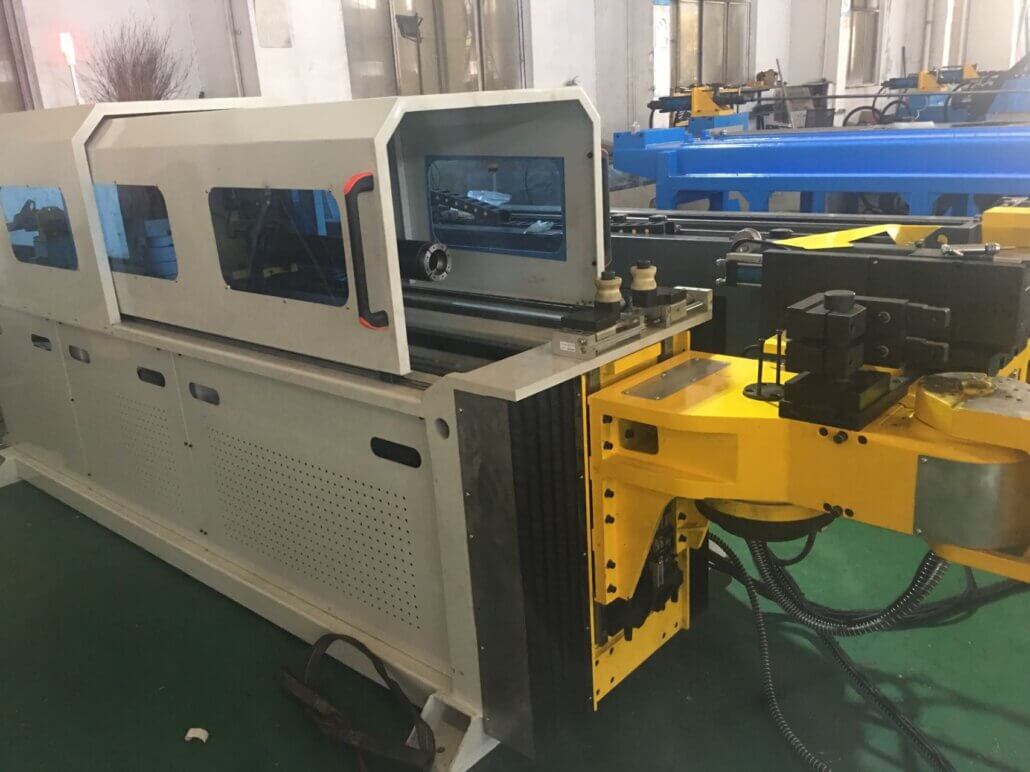
Fully Electric Tube Bending Machine
A fully electric tube bending machine is entirely controlled and driven by electric servomotors, completely replacing the traditional hydraulic system, making the pipe bending speed more efficient and the pipe bending accuracy more precise.
All-electric tube benders may have 12 servo motors or more, they mainly control: the bending axis, feeding axis, rotary axis, support axis, clamping devices, positioning devices, adjustment devices, calibration axis, auxiliary axes, transmission devices, automation control, and fine adjustment. But this depends on your request, we’ll customize the machine to meet your needs. Our engineering team is adept at designing machines tailored to your specifications. Contact us to bring your ideal machinery to life.
Advantages of Fully Electric Tube Bending Machine:
High Precision: Tube bending with servo motor control, the bending accuracy is higher than that of the hydraulic system, allowing for more precise pipe bending.
Eco-Friendly: Compared to the traditional hydraulic system, all-electric machines can be able to save energy and reduce the hydraulic oil contamination produced by the hydraulic system.
Flexibility: Electric systems are easier to program and adjust different shapes and angles of tube bending easily.
Low Operating Costs: Due to this machine not needing hydraulic oil, hydraulic pumps, and other hydraulic system components, maintenance costs may be relatively low.
Disadvantages of Fully Electric Tube Bending Machine:
High Initial Investment: The initial investment of all-electric machine must be higher than hydraulic machine, due to the cost of the servo motor and relative control system is high.
Stringent Maintenance Needs: Electric systems have higher requirements for the stability of circuits and control systems and require more stringent maintenance and repairs. Once a fault occurs, repairs may be more complicated.
Restricted Application Range: For some special tube materials and tube shapes, all-electric tube bender may not be the best choice. Sometimes, hydraulic tube bending machines can provide greater bending adaptability. Send your request to us, we will help you to find the best bending solution.
The Application of All-Electric Tube Benders
The electric tube benders are widely used in automotive manufacturing, aerospace industry, furniture production, architecture and construction, medical equipment, and other manufacturing require precise and repeatable tube bending.
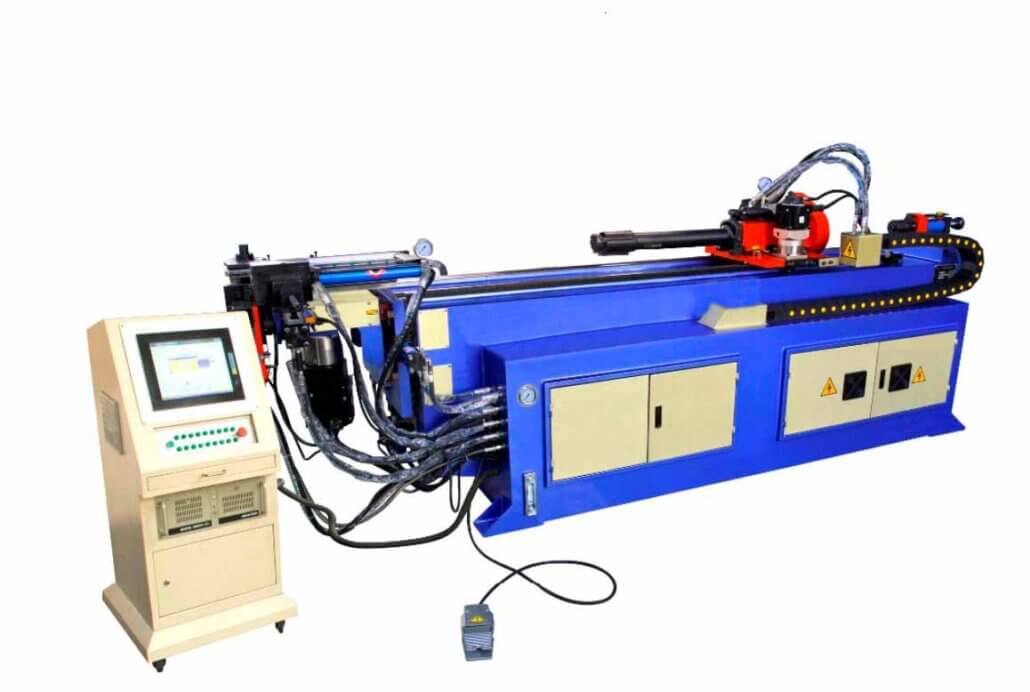
CNC Servo-Hydraulic Tube Bending Machine
CNC Servo-Hydraulic Tube Bending Machine is a precision-controlled tube or pipe bending machine, controlled by CNC (Computer Numerical Control) and driven by both servo motor and hydraulic system. This machine provides precise bending, allowing complex shapes and angles to be formed during the process.
Whether the motion components are driven by the hydraulic system or servo motor depends on your needs. The factors that affect the manufacturer to choose which driven system are:
Accuracy Requirements: Servo control provides higher accuracy and faster speed. If you need to ensure the bending accuracy and working speed, such as bending angle, complex bending shape, and bending movement, you will need these parts to be controlled by servo motor.
Strength and Pressure Requirements: Hydraulic provides greater power and pressure output. For example, if you are going to bend large diameter and thick wall pipes.
Cost and Maintenance: Cost and maintenance is also an important factor, Servo control systems have higher initial costs but lower maintenance costs over the longer term. Hydraulic systems have a lower initial cost but higher maintenance cost in the subsequent operation of the machine.
Application: Some applications require high accuracy, fast speed, great power, and other needs, the chosen driven system will also vary according to specific industry.
Advantages of CNC Servo-Hydraulic Tube Bending Machine
Bending Capacity: Compared to all-electric tube bending machine, the servo-hydraulic tube bending machine can bend larger tubes and thicker tubes with bigger power.
Bending Accuracy: Can achieve high accuracy bending and repeated production.
Wide Adaptability: Driven by hydraulics will be more suitable for high-strength alloy tube, which requires great power, this is why some industries don’t like to use fully electric tube bender.
Multiple Bending Request: Machine can be installed with multiple layers of bending dies, accommodating multiple curvatures and diameters, allowing for mixed bends.
Reduce Labor: You can install the automatic loading and unloading device on this machine, to achieve unmanned automation.
Lower Energy Consumption: With hydraulic system mixed, this machine can reduce energy consumption, compared to the full electric tube bending machine.
Disadvantages of CNC Servo-Hydraulic Tube Bending Machine
Relatively High Cost: The machine cost is lower than all-electric tube bending machines but higher than most tube benders in the market.
The Application of CNC Servo-Hydraulic Tube Bending Machine
Most clients opting for CNC servo-hydraulic tube bending machine are involved in industrial-scale production, and the machine’s stability has garnered widespread favor among our clientele. This machine are widely used in automotive manufacturing, aerospace industry, engineering construction, furniture manufacturing, energy industry, and other industries that require high accuracy, multifunctional and complex tube bending.
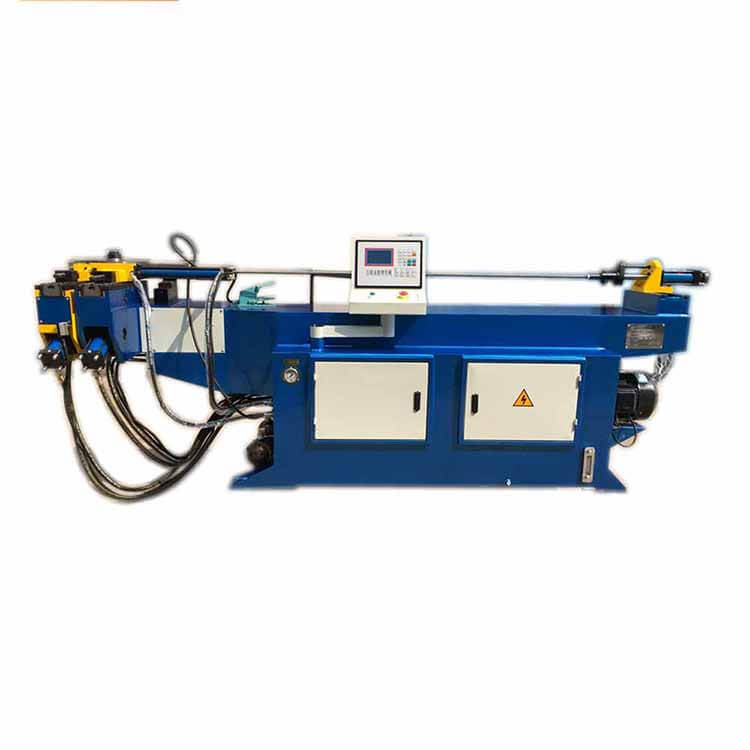
NC Tube Bender
The NC tube bender is relatively simple, it is a hybrid between CNC tube bender and manual tube bender. This machine is numerical control and bending by hydraulic system, the bending accuracy is ±1mm. Two main types of NC tube benders in the market: Semi-Automatic NC Hydraulic Tube Bending Machines and Twin Head Tube Benders.
Semi-Automatic NC Hydraulic Tube Bending Machine
The semi-auto NC tube bender is known as semi-automatic pipe bending machine by the public. This machine is driven by hydraulic system and is widely used to process a single bend or multiple bends on the plane. On this machine, bending action is processed by hydraulic, feeding, and rotating pipe is by manually. Bending speed is controlled by solenoid valves.
Advantages of Semi-Automatic NC Hydraulic Tube Bending Machine
Low Cost: The cost of investing in this machine is very low.
Easy Maintenance: The maintenance of this machine is very easy. If you are an experienced factory, this is something very easy for you.
Parameter Settings: The touch screen is very easy to set up and operate, reduces the difficulty of training your operating workers
Versatility: You can proceed with different tube materials of various sizes.
Disadvantage of Semi-Automatic NC Hydraulic Tube Bending Machine
Accuracy: Compared to CNC-controlled automatic pipe bender, the bending accuracy of semi-auto tube bending machine is only ±1°.
Productivity Constraints: This machine needs to feed and rotate pipe manually, production speed is not as fast as automatic.
Flexibility: The semi-auto tube bending machine can not bend complex bends.
Application of Semi-Automatic NC Hydraulic Tube Bending Machine
Semi-auto NC tube bender also can be used in automotive manufacturing, the aerospace industry, engineering construction, furniture manufacturing, energy industry. However, this machine only allows for proceeding simple bends, such as general piping fabrication, structural components, and some other general shape pipe bending.
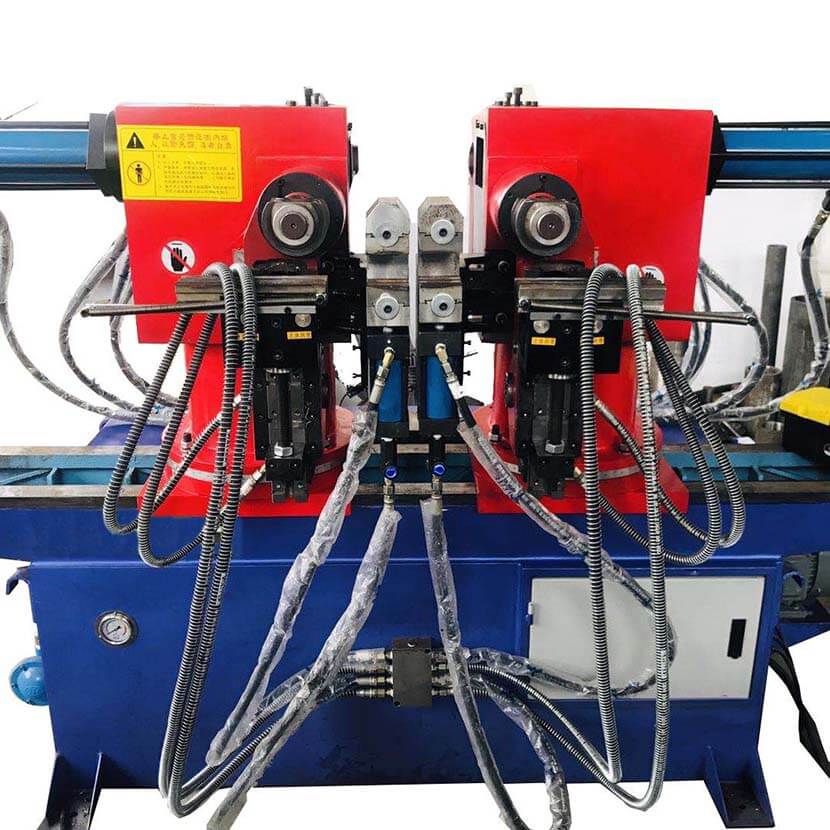
Twin Head Tube Bender
Twin head tube bending machines are famous due to their simultaneous dual bending capabilities. This type of machine is driven by hydraulic system and usually doesn’t have a mandrel insert into the tube while bending, but it’s always been classified as a subtype of mandrel tube bender, due to the similar function of these machines.
Advantages of Twin Head Tube Bender
Easy Operation: The machine is designed for easy operation.
Batch Production: Suitable for batch production where multiple identical or symmetrical bends are required within a single tube.
High Efficiency: Bend 2-4 pieces at one time.
Low Cost: The cost of investing in this machine is also very low.
Disadvantages of Twin Head Tube Bender
Bending Performance: Bending pipe by this machine does not have the mandrel support, so the bending performance can not be comparable to the mandrel tube bender.
Bending Complexity: This machine only allows to bend simple, but symmetrical bends.
Working Capacity: The twin head tube bending machine can not bend large diameter tubes. Find your best tube bending solution here.
Application of Twin Head Tube Bender
The twin head tube bender is very suitable for bending metal tube frames that require symmetrical tube bends at both ends, such as shopping trolleys, table & chair frames, baby strollers, etc.
What Materials Can Be Bent on Mandrel Tube Bender?
Mandrel tube benders are widely used in industrial production, they can bend carbon steel tubes, stainless steel tubes, aluminum tubes, copper tubes, titanium tubes, nickel tubes, etc.
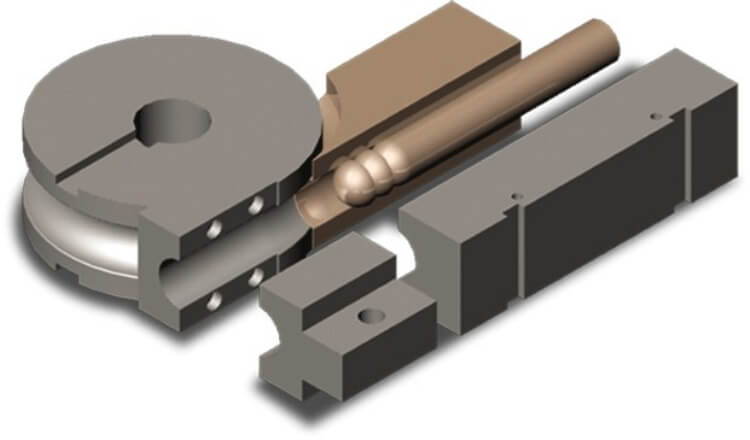
Better Understanding on the Drive System of Mandrel Pipe Bending Machine
There are 3 types of drive systems used in the mandrel pipe bending machine in the market, they are: hydraulic system, hydraulic+servo system, and all-electric system. Let’s take a deep step to better understand them.
Hydraulic System
The hydraulic system is commonly used in the NC semi-auto pipe bending machine. The machine is powered by motor and through hydraulic valve group to control the movement of the cylinder to achieve the overall operation of the equipment. This technology is very mature, if your request is to keep on stable and consistent tube bending, but without very high bending accuracy needs, this type of machine is very economical for your investment.
Hydraulic + Servo System
The hydraulic+servo drive system is mainly used in CNC automatic tube bending machines. The allocation between hydraulic systems or servo systems for control depends on your priority for efficiency and accuracy. Generally, we will use servo motor to control tube feeding, tube rotating, tube bending, and tool changing, use hydraulic to control clamping, pressure, pulling, etc. This technology is versatile for bending tubes from small diameter to large diameter with precise bending accuracy. Investing in the machine with this driven system is more economical than fully electric tube bender.
All-Electric System
Using all electric systems, all machine action will drive by the servo motor. Under this method, you will get absolutely precise bending accuracy, precise positioning, quick working speed, very little noise, and stable tube bending quality. But, the cost of investing in this machine is very high.
What is the Commonly Used Control System in the Mandrel Tube Bender?
Depending on the different requests for the mandrel tube bending machine and the function you want to get, you will need different control system to help you to meet your needs. There are 4 types of control systems in the market usually used in the machine.
Microcontroller System
Feature: Using single-chip microcomputer to perform the basic functions.
Advantage: Low cost, easy to operate, suitable for single tube bending requests.
Restriction: Limited functions, different to expand or execute complex control algorithms and suitable for simple application scenarios.
PLC Control System
Feature: Control is performed by programmable controller, which performs control tasks through a logic programming language.
Advantage: Stable, can achieve more complex logic control, easy to program and maintain.
Restriction: The function is relatively limited, suitable for medium-complexity pipe bending needs.
Industrial Computer System
Feature: Use industrial-grade computers as the control core, equipped with advanced software and algorithms to achieve complex control and data processing.
Advantage: Robust computing power, high flexibility, suitable for complex, high-precision pipe bending tasks and data processing needs.
Restriction: Higher cost and complexity may make configuration and maintenance difficult, it required your company should have senior engineers.
PLC + Industrial Computer System
Feature: It combines the logic control of PLC and the advanced functions of industrial computers, with both logic control and powerful data processing capabilities.
Advantage: It combines the stability and logic control of PLC with the advanced computing power of industrial computers.
Restriction: Relatively higher cost and need more expertise.
Want to know how to bend pipe accurately?
Interested in how the mandrel pipe bender works?
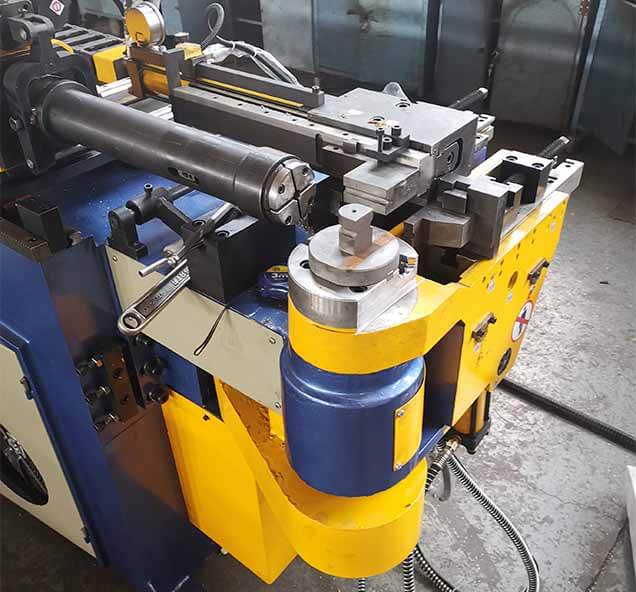
All about Pipe Bending Tools
Pipe bending tools are an important part of pipe bending machine, they are used to shape the pipe into your desired angles and curves.
Types of Pipe Bending Tools
Bending Die: Bending die is designed according to your bending radius.
Clamp Die: Clamp die is designed to hold your pipe firmly with the bending die, in order to prevent unwanted movement during the process.
Pressure Die: Pressure die provides the counterpressure against the pipe. Especially for the thin wall pipe, this die can greatly reduce the risk of tube deforming or tube collapsing during bending.
Wiper Die: Wiper die is designed to eliminate wrinkles or distortions that might occur on the outer radius of the pipe.
Mandrel: Mandrel is designed to insert into the pipe while bending, in order to prevent buckling or deformation on the inner radius of the bend. The number of mandrel balls depends on the bending radius and bending angles.
Material of Pipe Bending Tools
The tube bending tool material can vary according to your tube material. The most common materials used in the bending die, clamping die and pressure die are 45#, Cr12, Cr12MoV, and 42CrMo. Cr12MoV material is always used due to the low cost. 42CrMo material is also another good choice for better quality but at a higher price. Sometimes, nylon material is also used in the clamping and pressure die, in order to prevent scratching on the aluminum surface. Generally, copper alloy is used to make the wiper die.
You may be interested in what is mandrel pipe bending?
When do I need a Mandrel to Bend a Pipe?
When bending a pipe, not all the situation you will need a mandrel and do you know when you will need it and when you can neglect it? TubeBenderN, as the professional manufacturer of mandrel tube bender, will tell you the secret today.
In the pipe bending industry, there are some professional terminology abbreviations you need to know: D means the outer diameter of the tube, T means the wall thickness of the tube, and R means the bending radius of the tube. The thinner the wall of your pipe and the smaller the bending radius, the more difficult it will be to bend the pipe.
Let’s see if your relative wall thickness (tx) and relative bending radius (Rx) are within the range. If the Rx>3D and tx>0.04, and your application doesn’t have a very high and precise request on bending result, you can neglect to use mandrel during this range. But if the Rx <3D and tx <0.04D, you must use mandrel to ensure the bending quality. (tx = t / D and Rx = R / D)
How do I Know Which Mandrel Fit for My Request?
When you choose a mandrel to bend pipe, you should mainly consider the 2 aspects:
- Type of Mandrel: The main types are divided into plug and ball mandrels.
- Size of Mandrel Ball: Due to the mandrel is inserted into the tube, the distance between mandrel and tube inner wall is very important. If the distance is too small, the tube wall will be strained or break. If the distance is too large, the tube will be wrinkled or flattened. You can decide the mandrel size according to this formula: d ≈ (0.94 to 0.98) D. (Here, d means mandrel diameter and D means tube inner diameter)
Mandrel Toughness and Lubrication: The mandrel should be deburred, polished, and cleaned, in order to avoid scratches on the tube inner wall. You should also lubricate the mandrel properly for better use.
What is Pipe Bending Radius?
The bending radius means the curvature radius measured along the centerline of the bend in a pipe or tube. To ensure the perfect tube bending result, we usually suggest to our customer that the tube bending radius should be 2-3 times of tube diameter, at least 1.5 times. The larger the bending radius, the smoother the pipe will be.
For some applications that will need multiple bending radii on one pipe, you need to consider multiple stack tools to create different bending radii.
Note: Please do not confuse the bending radius and bending angle, check below indicator diagram, you can understand better.
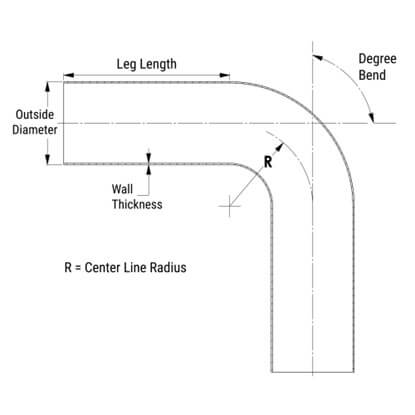
Customization Options for the Mandrel Tube Bender
The Mandrel Tube Bender itself is a highly customizable mechanical equipment used for bending metal tubes. It’s suitable for industrial-scale batch production to meet diverse bending needs across various industries. You can tailor it to match your requirements in various aspects. Below, let’s explore the areas you can customize:
Automation Level: Mandrel Tube Benders come in both fully automatic and semi-automatic versions. You can customize based on your production scale, technical capabilities, and cost requirements.
Bending Capacity: Customize the machine’s bending capabilities according to different metal tube materials, outer diameters, thicknesses, diverse bending shapes, and other specific requirements.
Bending Tools: This includes mandrels and various bending dies. Customizing these tools ensures they fit your tube sizes, different metal tube dimensions, varying bending radii, and materials.
Control System: Mandrel Tube Benders offer several control system options, catering from simple to complex bending demands. You can select different control systems based on your specific needs.
Precision Requirements: Different industries often have varied precision demands for tube bending. Choose different bending drive system configurations based on your precision requirements.
Multilingual Customization: As customers for tube benders come from around the world, if English isn’t your native language, you can customize the operating interface to your language for better machine operation by your workers.
Spare Parts: All components equipped in our Mandrel Tube Benders are sourced from globally renowned brands. You can easily find replacements locally when needed. Of course, you can also specify the brand for components when customizing machines with us.
Body Color and Logo: If you’re a local machinery dealer and have your logo and brand colors, customization options are available.
Safety Features: Customization for safety features such as emergency stop buttons, safety guards, sensors, etc., can be customized to meet your operational safety requirements.
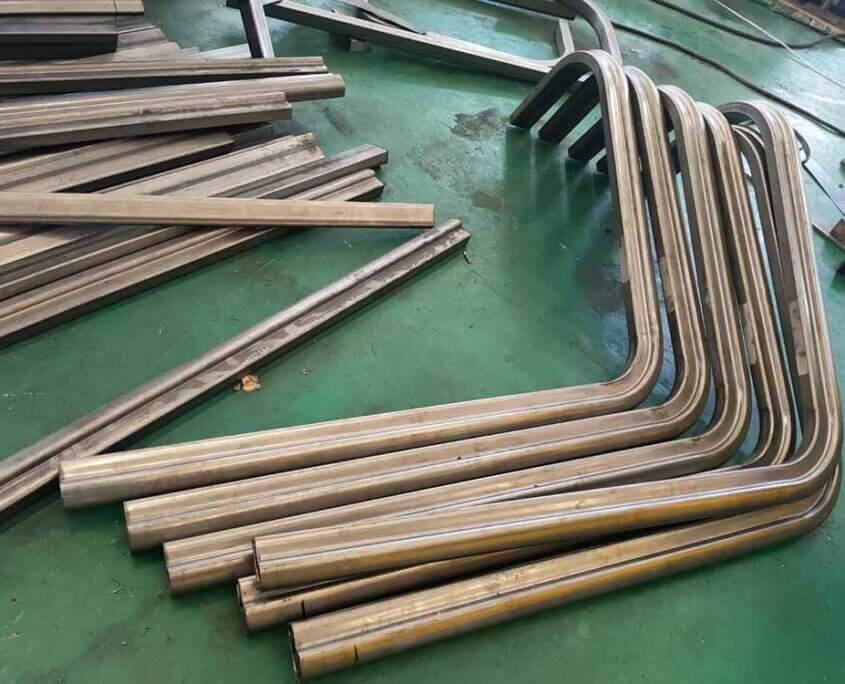
Common Issues & Fixes in Mandrel Tube Bending
Below are the issues that may occur during your tube bending, we also provide the solution for you. You can also contact our expert to get your best tube bending solution.
Serious flattening occurs in the cross-section of the bent segment
The causes of the issue: ① The mold cavity is not sufficiently smooth; ② The mandrel position is too far back or the mandrel ball is reduced, failing to effectively support the bent segment, resulting in collapse; ③ Insufficient die pressure at the bending point; ④ Slight slippage of the tube in the clamping die during bending, in which case, it’s necessary to check for any abrasions in the clamping section.
The solution: ① Inspect the mold cavity, if it’s not right, replace the mold. ② Move the mandrel forward, if unable to reach the bending arc point, increase the number of balls. ③ Increase die pressure and assistive pushing force. ④ If there are scratches on the clamping section, increase the clamping die pressure.
Excessive collapse of the bending segment
The causes of the issue: ① Inadequate mandrel support; ② Rotational speed greater than the pushing speed, and the tube clamped too tightly.
The solution: ① Move the mandrel forward, if insufficient, increase the number of balls. ② Convert the plug into a ball, adjust the rotational or pushing speed, and reduce die pressure.
Tool marks
- Sectional indentations in the clamping area
① Half-round indentation at the insert seam
The causes of the issue: Poor fit of inserts on the wheel die, resulting in steps.
The solution: Use integral molds or repair/adjust the mating surfaces of the inserts.
② Clamping marks at both ends or one end
The causes of the issue: a). For deep marks at both ends, excessive clamping pressure might be the cause; axial marks along with this indicate a larger tube diameter. b). For marks at one end, there might be an axial tilt in the clamping.
The solution: a). For deep marks at both ends, reduce clamping pressure and strictly control the tube dimensions. b). For one-sided marks, adjusting the clamping angle by adding copper behind the clamping die might help. When the straight section of the tube is shorter than the clamping die length, an additional support mandrel can be added to increase the clamping force.
- Axial marks in the clamping/die area
The causes of the issue: a). The clamping force is too high, and the mold cavity dimensions are either too large or too small. b). Misalignment in the center of the mold groove. c). This phenomenon can also occur when the tube diameter is large.
The solution: a). Use molds with the correct cavity dimensions. b). Align the center of the mold groove while appropriately reducing the clamping force. c). Strictly control the tube diameter size.
- Axial marks on the bent section
The causes of the issue: a). The die and wheel mold centers are not vertically aligned, or the mold cavity is too small. b). This phenomenon can also occur when the tube diameter size is large.
The solution: a). Adjust the vertical alignment of the mold centers, increase the clearance between the die and wheel molds, and reduce the die pressure. b). If marks persist, measure whether the tube diameter is a proper fit.
Inner side wrinkling during bending
- The entire bending arc is filled with wrinkles extending into the anti-wrinkle zone.
The causes of the issue: a). The anti-wrinkle die is positioned too far back, with a slot size insufficient to support the tube wall effectively. b). There’s excessive clearance between the die and anti-wrinkle/ wheel molds, coupled with low die pressure. c). Additionally, the mandrel diameter and positioning are incorrect.
The solution: a). Inspect the mandrel diameter size and the mold slots, selecting the appropriate molds. b). Reduce the clearance between the die and the anti-wrinkle or wheel molds, increase pressure, and advance the anti-wrinkle die forward. c). Gradually advance the mandrel until achieving the desired outcome.
- Wrinkles appear between 45 to 90 degrees of the bending arc, mostly at the bottom.
The causes of the issue: a). The wheel mold cavity is not circular, and the alignment between the locating ring and block is off-center. b). There’s excessive clearance between the die and the anti-wrinkle or wheel molds, with low die pressure.
The solution: a). Reduce the clearance, increase pressure, and push forward the anti-wrinkle die. b). If necessary, sink the entire die cavity and use copper shims behind the die.
- Wrinkling on the straight section after the bending arc
The causes of the issue: a). The anti-wrinkle die has excessive tilt, failing to support the tube wall effectively. b). There’s a large gap between the anti-wrinkle die and the die. c). The straight section diameter of the mandrel is too small, resulting in excessive clearance after inserting the tube, failing to support the tube wall effectively. d). Excessive thrust force or mismatch between thrust speed and rotational speed. e). Check the wall thickness of the bent section; if there’s not much reduction in thickness, it suggests insufficient die pressure. f). Wear at the tip of the anti-wrinkle die, poor fit with the base and the wheel mold cavity.
The solution: a). Reduce the angle of the anti-wrinkle die and decrease the gap between the anti-wrinkle die and the die. b). Check the wall thickness of the bent section; if meeting the required thickness, increase the die pressure. c). Inspect the diameter size of the mandrel and replace if too small. d). Adjust thrust pressure and ensure thrust speed matches the rotational speed. e). Repair the anti-wrinkle die, ensuring at least 80% contact area with the rear base and the wheel mold cavity, with a 2-3mm distance from the wheel mold cut point at the front, and uniform thickness at the tip.
Scratch
- Scuffing on the bending arc and anti-wrinkle zone
The causes of the issue: a). The tube surface has burrs. b). There are metal debris, chips, or irregular burrs on the die or anti-wrinkle die surfaces. c). The mandrel size is small. d). Inadequate die pressure causes relative sliding. e). Mismatch between the material of the anti-wrinkle die and the material being bent.
The solution: a). Increase the tilt of the anti-wrinkle die, die pressure, or surface roughness. b). Clean or polish the tube surface and the die cavity. c). Apply diesel or lubricating oil in the anti-wrinkle zone. d). Adjust thrust pressure or speed to match the rotational speed. e). Select an anti-wrinkle die material compatible with the material of the bent tube.
- The arc section has wrinkles, and there are linear abrasions in the clamping area.
The causes of the issue: a). The die clamping force and clamp force may not be aligned. b). The positioning of the mandrel and anti-wrinkle die may be incorrect. c). Low roughness in the die cavity. d). Metal debris, chips, burrs, or oil stains on the tube surface or in the die cavity. e). Excessive clamping force causes the die to press against the mandrel ball, leaving marks on the tube due to clamping.
The solution: a). Adjust the clamping force of the die and clamp. b). Inspect the positioning of the mandrel and anti-wrinkle die, and the lubrication condition. c). Apply carbide spray to the die cavity or increase its roughness. d). Clean or polish the tube surface or die cavity, ensuring no particles, burrs, or oil stains are present.
The wall thickness dimension is below the standard requirement
The causes of the issue: a). The thrust speed is lower than the rotational speed. b). High die pressure and low thrust pressure. c). The tube’s raw material has a smaller wall thickness.
The solution: a). Increase thrust force and thrust speed. b). Decrease die pressure or widen the gap between the die and wheel/anti-wrinkle die. c). Check the tube’s wall thickness around the circumference and favor the thicker side. d). Minimize the length of the tube’s end as much as possible while meeting dimensional requirements to facilitate metal flow.
A straight section appears before the end cut point of the bend
The causes of the issue: The mandrel fails to support the tube effectively; the mandrel pitch is too wide.
The solution: Re-machine the coupling joints of the balls to reduce the pitch.
Bending springback
The causes of the issue: When the tube is subjected to bending, the material in the tube wall undergoes both elastic and plastic deformation. Upon unloading, the portion deformed due to material elasticity inevitably seeks to return to its original shape, resulting in bending springback.
The solution: The main methods used for control are compensation and correction. Compensation involves comprehensive analysis of bending springback factors, estimating the amount of springback based on various conditions and trends during bending, and adjusting the dimensions and geometry of the working parts of the molds during design and manufacture to achieve an ‘over-bending’ effect. Correction involves implementing measures in the mold structure to concentrate corrective forces at the bending point, altering the stress state to eliminate elastic deformation and overcome springback. For instance, in the stretch bending process, applying tension during bending places the entire cross-section under tensile stress, aligning the elastic recovery upon unloading with the deformation direction, significantly reducing springback.
How Much Does a Mandrel Tube Bender Cost?
The cost of mandrel pipe bender depends on many factors, such as the type of machine, machine model, machine capacity, machine parts brand, the number of molds, etc. Contact TubeBenderN to find the best tube bending solution for you!
FAQs about Mandrel Tube Bender
Q: How to properly place the mandrel into the tube?
A: Improper position of the mandrel into the tube will cause bad bending results, so we have a formula for you to find the right place, that is: e ≤ (1/4 ~ 1/2) D. (e is the location of initial mandrel penetration into the pipe during the start of bending. D is the inner diameter of the pipe)
Q: Can I start mass production when each tooling is in its place?
A: No, you can start trial bending, then check the sample bending. If they look okay, you can start mass production. Or else, you need to make the appropriate adjustment.
Q: After every mold is positioned, why do my tube bends still have wrinkles?
A: This may be caused by one reason or a few reasons; you need to check carefully. There may be 7 main reasons for this issue.
- Mandrel Size is Not Fit: The mandrel is too small or too large.
- Bending Mold is Not Suitable for Bending Material: If you have multiple bending materials and multiple bending molds, please distinguish them clearly.
- Wrong Bending Parameters: Double check your bending parameters, such as bending speed, bending pressure, bending angle, etc.
- Mandrel Condition is Bad: If your mandrel is worn or has improper placement, the tube may wrinkle after bending.
- Tube Sliding: If the tube slides in the clamping die, the issue will also occur.
- Wiper Die Condition is Bad: If the wiper die is worn or improperly installed, tube wrinkles will occur.
- Improper Lubrication: Excessive or improper use of lubricant can also easily cause damage to the pipe.
Q: If the bending mold is worn out, what should I do?
A: Bending mold is wearing part and if you find them have problems, do not hesitate to check or customize new tooling from us.
Explore the Wider World of Pipe Bending!
After reading this blog, we are confident that you can find everything you need about mandrel tube bender. TubeBenderN is a 15 years manufacturer of tube bending machine, focusing on providing customization services to fit your request in your specific application.
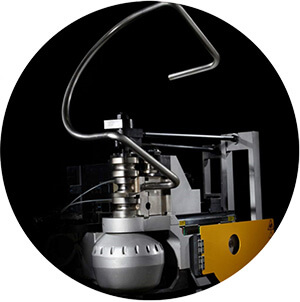
Denis Lau
Denis Lau has 20 years of work experience in the metal processing industry. His major in university was mechanical engineering, and after graduation, he started from the bottom of the workshop, gaining extensive hands-on professional experience and the ability to tackle challenges from various industries.
